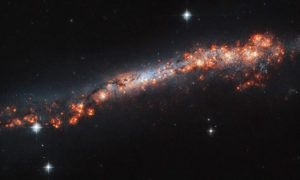By Evelyn C. McDonald
Arts & Culture Reporter
January 9, 2020

“Long, long ago in a galaxy far away…” Most people I know would recognize that phrase from the scrolling text that started the first Star Wars movie. I remember the night I saw the movie. We walked over to the theatre and were surprised to see a line stretching almost around the block. The movie didn’t disappoint. The actors, the cantina scene, the Jedi, the dark side of the Force became household words.
Last week I went to see the latest in the Star Wars franchise. While it didn’t quite have the impact of the first, it did get me thinking about the nature and persistence of Star Wars popularity. How did Lucas’ concept spawn so many sequels and spin-offs? In addition to the nine movies and one prequel movie, now there is a TV series, “The Mandalorian.”
Here’s a thought – Star Wars is a saga that uses all the elements of myth especially the Hero’s Journey. In most myths, heroes’ lives take a similar trajectory. Often heroes don’t know their parents and aren’t told the circumstances of their birth. They are drawn into their journey through the actions of others. And they undertake the journey to achieve what they believe is right.
You might argue that all of the movie sagas (Indiana Jones and Marvel Universe} are mythic sagas. However, the analogy doesn’t hold up. Jones knows his parents. He is already out adventuring and the stories are set in contemporary times. As for the Marvel Universe, although it features Thor and Loki from Norse myth, they are borrowed for a contemporary story.
You might also argue, as Martin Scorsese recently did, that Star Wars and those other stories are not art. They are splashy entertainment, full of battles and narrow escapes. That is largely true of several series and partly true for the later Star Wars episodes. If you go back to the first movie released, that argument doesn’t hold us as well.
In the first Star Wars, Luke undertakes the journey when his family is destroyed by the Empire. He doesn’t know his father at the start. He believes in the rightness of the journey even though it may be fatal to him. There is a mythic aspect to the battle between the Jedi and the Empire.
Mythic themes are in our DNA, you might say. We first hear them when we are children. We find them incorporated into art and culture, and we relate to them. Maybe George Lucas felt that as well and created his own homage to them.
 Evelyn McDonald moved to Fernandina Beach from the Maryland suburbs of Washington, D.C. in 2006. Evelyn is vice-chair on the Amelia Center for Lifelong Learning and is on the Dean’s Council for the Carpenter Library at the UNF. Ms. McDonald has MS in Technology Management from the University of Maryland’s University College and a BA in Spanish from the University of Michigan.
Evelyn McDonald moved to Fernandina Beach from the Maryland suburbs of Washington, D.C. in 2006. Evelyn is vice-chair on the Amelia Center for Lifelong Learning and is on the Dean’s Council for the Carpenter Library at the UNF. Ms. McDonald has MS in Technology Management from the University of Maryland’s University College and a BA in Spanish from the University of Michigan.

Thanks for this! I remember taking our children to the first film and all of us were entranced.
Just to add – Lucas spent quite a bit of time talking with Joseph Campbell, author of “The Hero’s Journey” and other books about myth, when he was planning the film and has acknowledged that Campbell was a large influence on the film sequence.
Thanks, Nancy. I didn’t realize there was a Campbell connection.